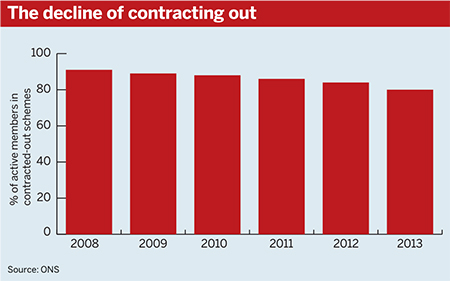Consultants have urged defined benefit scheme trustees and sponsors to take action as the one-year countdown to the end of contracting-out approaches.
From April 6 2016, national insurance contributions for both employers and defined benefit members will increase substantially with the introduction of a new single-tier state pension.
Five steps to deal with the end of contracting-out
1. Assess: consider options and impacts
2. Plan: identify and prioritise stakeholders
3. Engage: get stakeholder buy-in
4. Inform: conclude consultation
5. Make changes: manage implementation
Source: Hymans Robertson
But this April’s reform deadline for defined contribution is dominating the current efforts of many DB schemes, and consultants have warned against any further delays to planning for the end of contracting-out.
Rowan Harris, actuary at Barnett Waddingham, said employers need to sit down and take stock of their pension scheme and have a fundamental review of what they want to provide.
“With so much going on, employers just haven’t been thinking about this – it should be big news,” said Harris.
He added the statutory override allows employers to adjust and reduce their cost structure.
John Cockerton, senior consultant at Towers Watson, estimated the 2016 deadline will impact 1.25m employees in large and small DB schemes across the UK and could cost companies £1,000 a head.
“If you want to change your pension scheme to take account of the additional costs there is a raft of choices but... you have to consult with your workforce over a 60-day consultation,” he said.
Cockerton warned schemes against underestimating the timescales involved in member consultations, and stressed the importance of managing changes to member benefits.
“Adding that up, I’ve got six months in my mind at the very least,” said Cockerton.
He said it is “probably not the best” to carry out a consultation over holiday periods.

“There’s only three months left, therefore, for an employer to work out exactly what they’re going to do,” he said.
End of an era
Data released by the Office for National Statistics last month showed that in 2013, 80 per cent of active private sector DB members were in contracted-out schemes, having fallen from 91 per cent in 2008 (see graph).
The data also showed contracted-out schemes were more likely to be contributing higher amounts.
The weighted average contribution rate for combined employee and employer contributions was 22 per cent in contracted-out schemes compared with 15 per cent for those not contracted-out.
Balance sheets and pay cheques
Next year’s cessation will have a significant impact on the balance sheets of companies with active DB schemes, warranting significant attention from employers.
Jon Hatchett, head of corporate consulting at Hymans Robertson, said for employees with a gross annual salary of £30,000, employers’ annual NIC will increase by £824 a head.
Employee NIC will increase to £2,907 a year, up from £2,568, equating to a £339 annual drop in employee pay.
“In most instances employers can change scheme benefits to change the balance of these outcomes,” said Hatchett.
He added there was a range of potential benefit design solutions that employers could adopt to account for the difference to employee benefits.
“The employer pays, the employee pays or you get less pension; companies will go down different routes depending on their different circumstances and their appetite for spending more on pensions,” said Hatchett.
He urged organisations that have not yet engaged with employees about changes to benefits to do so urgently.
“Despite everything else that’s going on in pensions, it’s much easier to manage the conversations if you give yourself time to do it,” he said.














